The Streacom F12C Aluminum Desktop Case Review
by E. Fylladitakis on September 14, 2015 9:00 AM ESTThe Interior of the Streacom F12C Desktop Aluminum Case
Access to the interior of the Streacom F12C is deceptively simple. Two knobs can be seen at the back of the case that look like variable resistors / rheostats. Some might even confuse them for a fan controller. Actually, these knobs are the screws that hold the top panel attached to the body. Rotating them clockwise (they are upside down) will release the top panel. To reinstall it, simply place the top panel back on the case and rotate the knobs counterclockwise.
At first sight, the interior of the F12C chassis appears deviously roomy. That is because the entirety of the case is virtually empty. There are no drive cages or anything else installed inside the case, initially leading to the false suggestion that the F12C is much roomier than it really is.
There are two removable metallic support bars across the center of the case. Unlike with the majority of desktop cases, these are not really meant to enhance the mechanical strength of the chassis. The 4 mm thick aluminum frame of the F12C is exceptionally strong and does not require extra support. Streacom placed the bars there for the installation of cooling fans. The company formally states that these brackets support only two 120 mm fans. However, the truth is that their design and variable mounting points allow for the installation of 80 and 92 mm fans as well. Depending on the height of the motherboard's heatsinks and the location of the first PCI Express card, a liquid cooling radiator up to 240 mm long and 120 mm wide might also fit. Note that the first PCI Express card has to be installed on the second expansion slot for 120 mm fans or a radiator to fit though.
The real innovation with the F12C is the fan and drive mounting system. As mentioned above, there are no cages for HDDs nor mounting points for fans. All that can be found inside the F12C are four metallic bars on either side of the case, attached into a rail using a metallic clip. They can be removed by simply pulling the clip and unlocking it. These bars have holes and rails for the mounting of any 2.5" or 3.5" device or fan up to 120 mm. In fact, the drives can also be installed either vertically or horizontally. Liquid cooling radiators can be installed using these bars as well. Simply attach the bars to the device(s) of your choice, place them back into the rail and lock them with their metallic clips.
For the means of this review, we installed a Corsair AX760i with the red cable set, for strong visual contrast. It fits without issues inside the Streacom F12C and the modular cables help with the limited space. As there are no spaces to hide the cables into, cable management can be messy. However, you should not consider a PSU with too short cables, as they will be unable to reach the left side of the case and the graphics card(s). An ideal solution would be a relatively short and fully modular PSU from a manufacturer that offers short cable kits, allowing the user to use short cables for the devices near the PSU and longer cables for the devices to the left half of the case.
A standard ATX motherboard fits comfortably inside the Streacom F12C, under the assumption that no devices will be attached to the left of the case, below the motherboard. Unfortunately, there is no clearance between the motherboard and the left panel. In theory, this mounting system is a nearly perfect modular solution, allowing the user to have full control over the number and location of the hardware. Inside a small case like the F12C however, there are serious limitations. If a full ATX motherboard is installed, drives or fans installed to the left of the case will block the motherboard's headers or expansion slots. To make sure that nothing on the motherboard is obstructed only one 3.5" or two 2.5" drives fit vertically against the front of the case and, again, the 3.5" drive will limit the length of the graphics card. We feel that the F12C should have been just a little wider, allowing the vertical installation of drives and fans next to an ATX motherboard.
Despite the severe limitations if an ATX motherboard is installed, an ITX motherboard gives plenty of room for the installation of drives across the left side of the case, while a Micro ATX motherboard allows 2.5" drives and cooling fans to be installed without interference. There is also the space in front of the PSU, which is utilizing the same mounting system. With a large PSU such as the Corsair AX760i, there is little room for the installation of drives there, but it is not impossible to fit a couple of 3.5" or up to four 2.5" drives. A short, smaller PSU would open space for more drives or even a 120 mm fan/liquid cooling radiator.


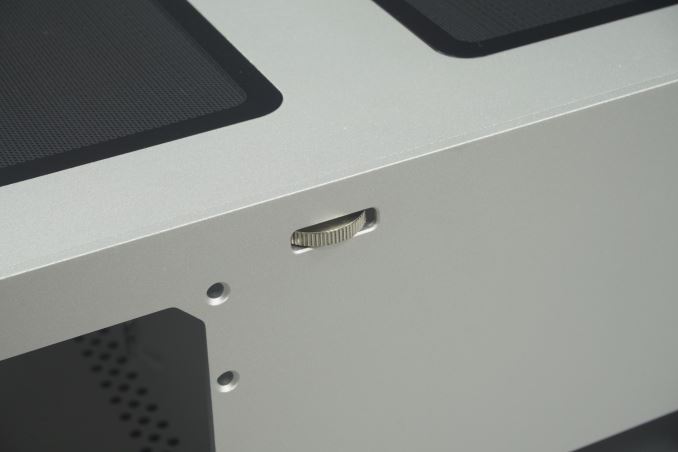
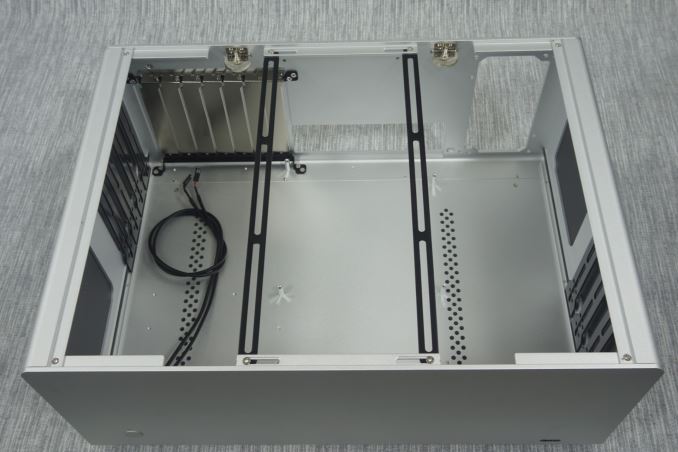
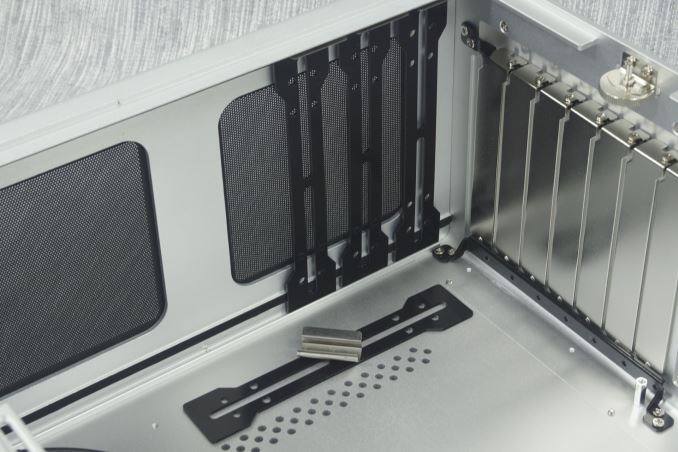
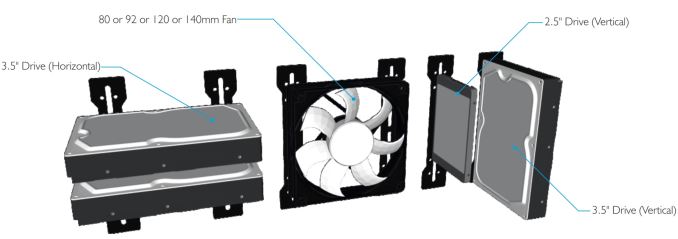
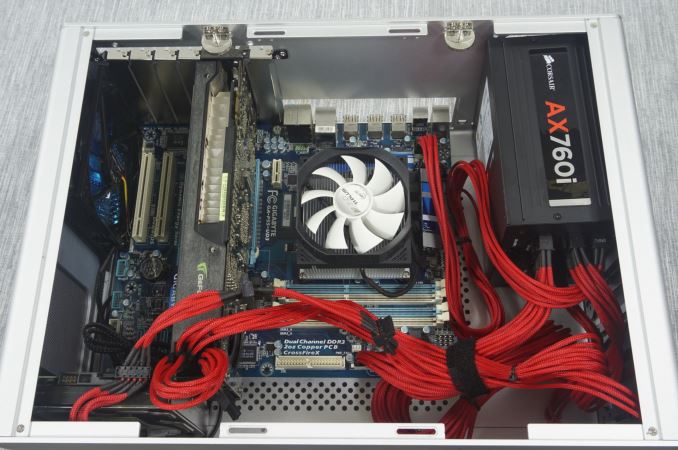
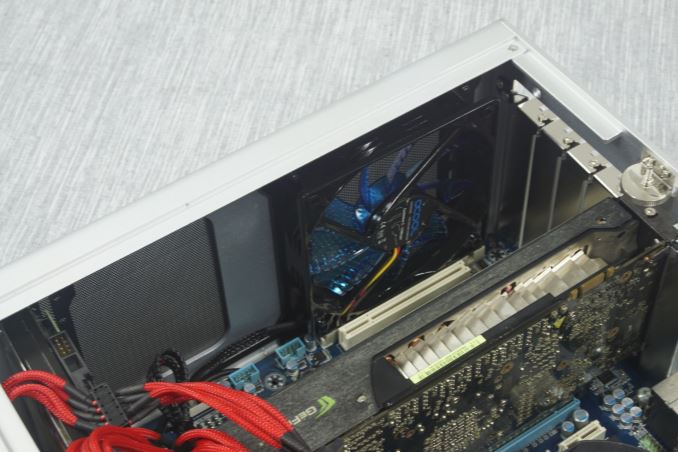
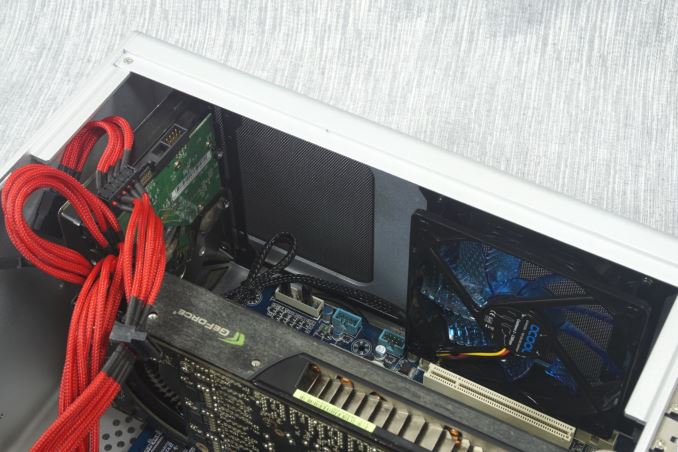








45 Comments
View All Comments
RaistlinZ - Monday, September 14, 2015 - link
A full tower case, put on its side, with ventilation all around...got it.Oxford Guy - Tuesday, September 15, 2015 - link
Not quite."It essentially looks like a typical tower case that has fallen on its side. An aluminum cover shields the expansion card slot screws. Strangely, there are no ventilation or fan openings, even though there is more than enough space of a small exhaust fan."
meacupla - Monday, September 14, 2015 - link
This might have been a decent product, if it were released 10 years ago.These days, it's all about compact mITX systems or compact streaming devices, like nVidia Shield.
Also, IR? really? BT/Wifi remote control is the way to go.
Odeen - Tuesday, September 15, 2015 - link
You can always add an internal USB RF remote receiver (Yaocoo makes one) to any case. The problem is that you're stuck with Yaocoo's remote. IR is important if you want to integrate the HTPC into a home theater system with an IR universal remote.RF is great, but it's not a solution until there's a universal RF remote
nmm - Monday, September 14, 2015 - link
It drives me nuts when I see fan mounts that block 30%+ of the fan area with mounts intended to be compatible with multiple fan sizes.http://images.anandtech.com/doci/9618/manual.jpg
The design is intended to be versatile, but in the end it just winds up being wasteful in my mind.
budabellyx - Tuesday, September 15, 2015 - link
Does it also make toast?Jhlot - Tuesday, September 15, 2015 - link
It looks like a toaster in the first picture.Oxford Guy - Tuesday, September 15, 2015 - link
"The noise of a finalized system will solely depend on the parts chosen by the user. We had to skip directly to our advanced noise testing, exploring the noise dampening capabilities of the case."Not good enough. If you're going to claim its temperature performance is such and such, after adding three fans — and compare that performance with other cases — then you need to post the decibel rating.
Cooling is about decibels per watt... how much noise is generated to cool a specific amount of waste heat. Without the decibel information your review is unfinished.
Oxford Guy - Tuesday, September 15, 2015 - link
It's also a contradiction to say the dust filtration sheets have holes that are too large to effectively capture dust and then praise them for being "very practical".Shouldn't a practical dust filter filter the dust?
E.Fyll - Tuesday, September 15, 2015 - link
And that's why we had its thermal performance posted without the fans - and compared it. A single sentence, "worse even than the BitFenix Neos", is better than five graphs.You may be right about dB(A)/W (although it does not work quite that way) but it is not useful to
I specifically wrote that the filtration sheets have holes that may be too large to stop small dust particles. That is a lot different than "effectively capture dust". If what you mean by "effectively" is "all of it", then the only filter you should consider is a solid wall.
Also, "practical" and "efficient" are two vastly different things. And stating that something is practical for a very specific reason is a very long shot from "praising".